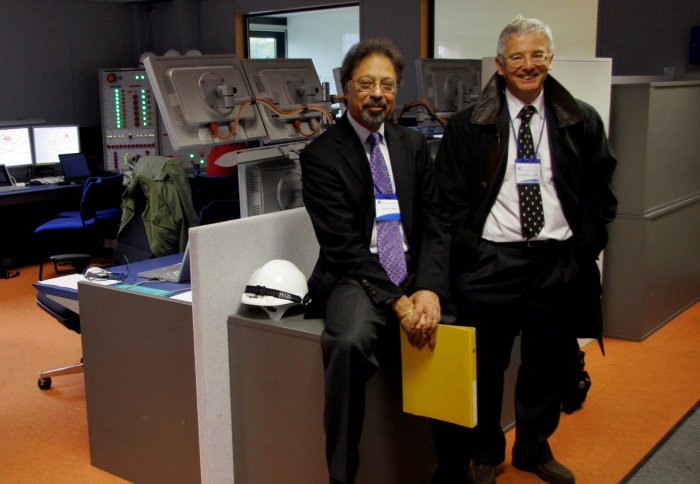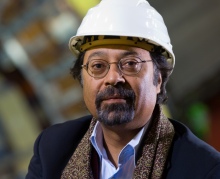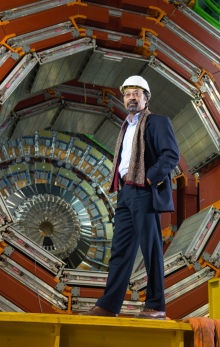
Professor Sir Tejinder Virdee (L) and Dr Michel Della Negra (R)

Two Imperial physicists share in a prize for experimental physics for their work masterminding the CMS and ATLAS experiments
The W.K.H. Panofsky Prize in Experimental Particle Physics, awarded by the American Physical Society, has this year been given to three scientists, "For distinguished leadership in the conception, design, and construction of the ATLAS and CMS detectors, which were instrumental in the discovery of the Higgs boson."
Their dedication for more than two decades to the design, construction, and operation of the CMS detector has been essential to enabling the wonderful science and discoveries we have seen at the LHC.
– Professor Jordan Nash
Head of Physics
Receiving the honours are Professor Sir Tejinder (Jim) Virdee FRS from the Department of Physics at Imperial, Dr Michel Della Negra from CERN, who is also a Distinguished Research Fellow at Imperial, and Dr Peter Jenni from CERN and Albert-Ludwigs-University Freiburg.
In July 2012, scientists using the Compact Muon Solenoid (CMS) and A Toroidal LHC Apparatus (ATLAS) experiments operating at the Large Hadron Collider (LHC) at CERN announced the discovery of the Higgs boson. This new particle, whose associated field gives mass to the fundamental particles, is the last missing link of the Standard Model of particle physics.
Professor Jordan Nash, head of the Department of Physics at Imperial, said: “I’m delighted to see that Jim and Michel have been awarded this year’s Panofsky prize. Their dedication for more than two decades to the design, construction, and operation of the CMS detector has been essential to enabling the wonderful science and discoveries we have seen at the LHC.”
Hayley Dunning talked to Professor Virdee about his latest award, chasing the Higgs and the future of the Large Hadron Collider.
You’ve won a few prizes for your work – how does it feel to win the W.K.H. Panofsky Prize?
 It is a great honour to receive this prize and it is particularly pleasing to get this recognition from our peers. Even though the past 25 years have been long and not without many difficulties, it has nevertheless led to a fantastic result for all of us at the LHC - the discovery of the Higgs boson.
It is a great honour to receive this prize and it is particularly pleasing to get this recognition from our peers. Even though the past 25 years have been long and not without many difficulties, it has nevertheless led to a fantastic result for all of us at the LHC - the discovery of the Higgs boson.
This award is also acknowledgement of the huge experimental effort that led to the discovery of the Higgs boson. This wouldn’t have been possible without the contributions of thousands of scientists and engineers from around the world. On a personal note, I have enjoyed the enormous support of my exceptional colleagues at Imperial as well as the many others in the CMS Collaboration.
What attracted you to particle physics and big experiments like the LHC?
Particle physics is a modern-day name for the centuries-old effort to understand the fundamental laws of nature. I was intrigued to find out more: how nature really works at the most fundamental level, and I’ve always felt that this has to be one of the most exciting of human endeavours.
Particle physicists didn't really set out to do ‘big’ experiments. I, like my colleagues, were not attracted by the magnitude of the experiment, but by the magnitude and importance of the questions for which we were searching answers. CMS has the size it has due to the huge power of its ‘microscope’ to examine physics at the smallest distance scales offered for study by the highest accelerator energy so far achieved.
And this can be seen in the history of this endeavour: twenty-five years ago, we started CMS with a handful of physicists and engineers. The enormity of the detectors that were necessary to answer these enormous questions meant that the collective talents and resources of a worldwide effort would be necessary. Now, CMS has over 3,000 scientists and engineers and involves 40 countries.
Did you always believe you would be able to find the Higgs boson with CMS and ATLAS?
 In retrospect, and not overlooking the open mind that we all physicists have to have, I did believe, that if the Higgs boson were a true constituent particle of nature, we would find it sooner or later at the LHC. It has to be remembered that mass is a fundamental attribute of fundamental particles and is what gives our universe substance.
In retrospect, and not overlooking the open mind that we all physicists have to have, I did believe, that if the Higgs boson were a true constituent particle of nature, we would find it sooner or later at the LHC. It has to be remembered that mass is a fundamental attribute of fundamental particles and is what gives our universe substance.
At the time of conception of the CMS detector, a few of us paid particular attention to conjectures that suggested the mass of the Higgs boson could lie in the range where, years later, in 2012, it was eventually found. In this range the electromagnetic calorimeter, which I pioneered, played a vital role. Similarly, other parts of CMS were conceived, designed and constructed so as to ensure that the Higgs boson would be found if it were at other masses.
Luckily, it turned out that the Higgs boson is a choice of nature. What was less of a stroke of luck is that we found it – given that it is a real element of nature.
What are you working on now, and what do you hope for the future of the LHC experiments?
My current work involves the in-depth study of the properties of the newly found Higgs boson, the search for widely anticipated physics beyond the Standard Model, and the design of the upgrades to the CMS detector for very high luminosity (implying very high proton-proton interaction rate) LHC running, due to start in the mid-2020s.
In the context of this upgrade, a year or so ago I began another exciting project to develop a novel technique to replace a part of CMS. The goal is to increase the physics reach of the next phase of the LHC and take us into the 2030s. In 2015 I was awarded an EU-ERC Advanced grant to carry out the research, development and prototyping of this novel project.
Article text (excluding photos or graphics) available under an Attribution-NonCommercial-ShareAlike Creative Commons license.
Photos and graphics subject to third party copyright used with permission or © Imperial College London.
Reporter
Hayley Dunning
Communications Division

Contact details
Tel: +44 (0)20 7594 2412
Email: h.dunning@imperial.ac.uk
Show all stories by this author
Leave a comment
Your comment may be published, displaying your name as you provide it, unless you request otherwise. Your contact details will never be published.




Comments
Comments are loading...